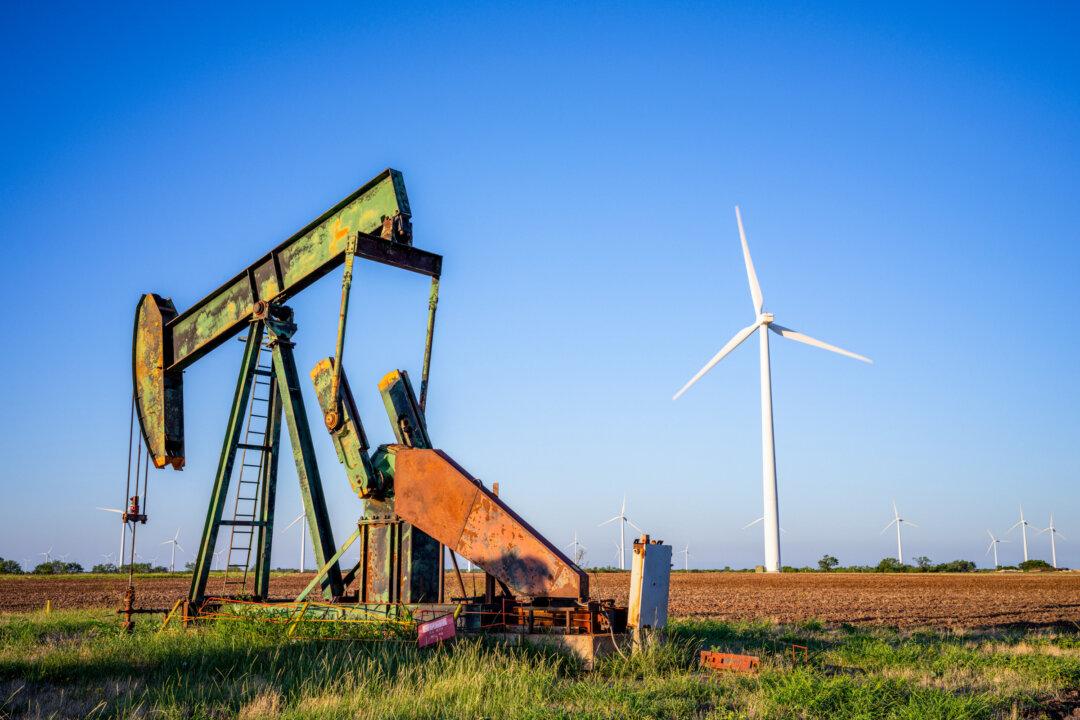The U.S. Department of Energy (DOE) is congressionally mandated to spend $32 million each day for the next 1,261 days to “exhaust” nearly $500 billion before a Sept. 30, 2026, deadline authorized under four Biden administration economic stimulus bills adopted since 2021.
Two bills don’t include funding for compliance assurance, while the other two earmark marginal allocations for fraud detection within “administrative cost” allowances.
As a result, DOE’s Office of Inspector General (OIG) is “too under-resourced for oversight” in monitoring spending approved under the same four measures that usher in an “unprecedented expansion in the department’s funding and mission,” DOE Inspector General Teri Donaldson told a congressional panel during an April 18 hearing.
At a House oversight hearing with the Department of Energy, Donaldson and DOE Deputy Under Secretary Dr. Kathleen Hogan testified on how the department has handled spending during the past two years since its budget more than doubled.
Donaldson and Hogan lobbied for a $1.6 billion boost for OIG manpower and resources across all federal departments.
If approved, DOE’s OIG could access a $150 million fund to augment the department’s $165.2 million FY24 budget request for its OIG contingent, which Donaldson said is nearly $17 million short of what she estimates is needed to track compliance as spending swells in coming years.
The bottom line, Donaldson said, is too much money came—and is still coming—too fast for undermanned inspectors general to adequately scrutinize. This is especially true for the DOE, which saw its annual budget balloon from $44.3 billion in 2022 to more than $128 billion in 2023.
She said the four Biden administration bills create 71 new programs, “a staggering number,” which will just be getting off the ground in the coming year.
“That is a dramatic increase” in spending without corresponding enhancement in scrutiny, subcommittee chair Rep. Pat Fallon (R-Texas) said. “Using the IG’s own words, ‘That’s a lot of money moving fast.’”
Fallon and the other eight Republicans on the 15-member panel said fraud and waste were virtually assured under “Biden’s spending spree” after the rapid adoptions of the Infrastructure Investment and Jobs Act (IIJA), Inflation Reduction Act (IRA), CHIPS and Science Act (CHIPS Act), and 2023 Consolidated Appropriations Act’s Puerto Rico Energy Resilience Fund.
The OIG, DOE, and other federal agencies are proposing reforms in how they monitor spending, but the proverbial cow has left the barn, Fallon said.
“Hundreds of billions of dollars shoved out the door and into, in many cases, the hands of criminals and fraudsters,” he said, noting the 71 new DOE programs present “a lot of new risk [for taxpayers]. That is a danger cocktail.”

Budget Balloons to $128 Billion in One Year
The IIJA appropriated more than $62 billion over five years to DOE, with most of those funds available through FY31 to establish 60 new programs, including 16 demonstration and 32 deployment projects, under the direction of a newly created Undersecretary of Energy for Infrastructure.In FY24, up to $52 billion of IIJA funding, or more than 83 percent, will be disbursed in grants, with most awarded to states, local governments, and tribes. In FY21, Donaldson noted, DOE disbursed $3.9 billion in grants.
The DOE OIG was “already significantly underfunded” but was left with little additional capacity—.10 percent, or one-tenth of 1 percent funding increase—to follow a landslide of money from the IIJA, also referred to as the Bipartisan Infrastructure Law (BIL).
The IRA appropriated $35 billion for DOE programs, including 15 new ones, with funding available between FY26 and FY31.
The IRA “significantly expanded [DOE’s] loan authorities such that the total of all existing department loan authorities, including those contained in IIJA and IRA, is now estimated at $350 billion,” Donaldson said.
The IRA appropriated $20 million to DOE’s OIG, or just .05 percent of the appropriation, although the bill provides “some additional flexibility on administrative expenses,” she said.
DOE has made $37.8 billion available from the IIJA, with $11 billion awarded or selected for negotiation, and $7.1 billion available from the IRA with $1.6 billion awarded or selected for negotiation, Donaldson said, with much more to come.
“This longer-term, infrastructure-focused mandate” differs from usual infrastructure funding, Hogan explained, which is “more focused on shovel-ready projects” than with research and development initiatives that constitute significant components of the four measures.
The CHIPS Act authorized $67 billion in spending for DOE’s Office of Science and other research and development projects at DOE laboratories nationwide.
“Of this $67 billion, $30.5 billion represents an expansion of their existing authorization,” Donaldson said, noting she will be seeking a .35 percent administrative cost fee “on those funds to conduct appropriate oversight.”
Under the 2023 Consolidated Appropriations Act, Congress added $1 billion to DOE appropriations to provide grants to the Puerto Rico Energy Resilience Fund to be managed by a new Grid Deployment Office.
There was no provision for DOE OIG oversight in the CHIPS Act or the Puerto Rico Energy Resilience Fund, Donaldson said.

DOE Already Plagued With ‘Lack of Oversight Resources’
Even before this “unprecedented expansion in the department’s funding and mission,” DOE already had a “high-risk portfolio,” with approximately 90 percent of its annual budget dispersed to contractors and 30 percent of that disseminated to subcontractors.Donaldson said there have been “numerous reports issued over the years by the OIG and the Government Accountability Office [GAO]” citing DOE’s “lack of oversight resources in particular areas.”
She said the OIG/GAO reports documenting lapses in oversight typically induced DOE’s “concurrence that it lacked the resources” to properly monitor money as it was going out the door.
In November 2022, the OIG wrote to DOE Secretary Jennifer Granholm explaining that the department’s oversight capacity was inadequate to “properly oversee appropriated funds and loan authorities” under the IIJA, IRA, and CHIPS Act.
OIG identified a series of special reports that detail DOE’s “risks of insufficient federal staffing, potential conflicts of interest, recipient fraud, and inadequate internal controls,” among other issues.
Those reports showed “key oversight functions such as invoice reviews were not performed due to limited staffing and heavy workloads of project oversight officials,” House Oversight and Accountability Committee Chair Rep. James Comer (R-Ky.) and Fallon said in a March 29 letter to Granholm.
Comer and Fallon identified “alarming signs of waste, fraud, and abuse” in three DOE offices—the Office of Energy Efficiency and Renewable Energy (EERE), Office of Fossil Energy and Carbon Management, and the Vehicles Technology Office.
Donaldson and Hogan did not contest the fact that DOE’s compliance monitoring was already suspect when it got buried in money.
Adding more than $128 billion in authorized direct appropriations and $350 billion in loans to manage to an already stressed oversight scenario virtually ensured that “inevitably, many program-specific risks will emerge and create enormous challenges for the department,” Donaldson said. “This will happen over time.”
She said between IIJA and IRA, $83.6 billion is going to 71 new DOE programs that “raise immediate concerns” in manpower and “effective internal controls” in steering money through “untested processes and newly designed and untested” compliance checks.
“History has taught us that the federal government has often balanced the ‘need for speed’ against the need for thoughtful internal controls in a manner that has resulted in the loss of billions of dollars to fraud, waste, and abuse,” Donaldson said.
If the fraud and waste that marred the allocation of more than $7 trillion in pandemic assistance approved in 2020 and 2021 is an example, inspectors general shouldn’t have a hard time exposing schemers and scammers nestled in the subsequent slate of federal appropriations approved under the Biden administration when Democrats controlled both chambers of Congress.
“These staggering losses should give all of us pause,” Donaldson said. “While [DOE] has stated that its new funding will not be released at the same speed that the pandemic funding was released, [it] has also publicly stated its sense of urgency to move these funds along to their intended purposes.”
As a result, she warned, DOE risks falling into a “pay-and-chase’ model of oversight that may result in substantial losses.”

No Dollars for ‘Chinese Entities’
To monitor the flood of funding, in addition to oversight on standard budgetary allocations, the DOE in January 2022 created an Under Secretary for Infrastructure position. Hogan is serving as the new under secretary in an acting capacity.The new under secretary is managing three new DOE compliance-assurance offices—the Grid Deployment Office, the Office of Manufacturing & Energy Supply Chains, and Office of State and Community Energy Programs, she said.
“This new structure will maximize the effectiveness of IIJA and IRA programs and boost DOE’s ongoing work to reduce energy costs through low-cost clean energy resources, create jobs and stimulate American manufacturing and industrial competitiveness, increase equity and environmental justice, and support meeting ambitious climate goals,” Hogan said, calling it a “strategic realignment” that allows DOE “to be nimbler and more responsive.”
Since “Day One” in her new capacity, she said, she has been ferreting out fraud and waste, working with inspectors general “to mitigate risks,” meeting with OIG 27 times in the past 15 months.
“The decision to award hundreds of millions of dollars to a company primarily operating out of the PRC raises questions about DOE’s commitment to safeguard our critical mineral supply chain,” Comer and Fallon wrote in their letter to Granholm.
Several GOP panel members raised the issue during the hearing.
Hogan said the company, Microvast Holdings, was selected to bid on a project but during routine oversight—the next stage in the process—its Chinese roots were revealed, she said.
Nevertheless, Reps. Anna Paulina Luna (R-Fla.), Scott Perry (R-Pa.), and Chuck Edwards (R-N.C.) each raised Microvast when questioning Hogan, with Edwards asking for assurance she was “not aware of any of this money going to the CCP.”
“These dollars will not go to Chinese entities,” Hogan said.





